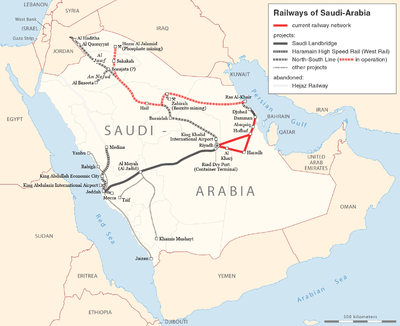Saudi Landbridge Project
| SRO Saudi Landbridge Project | |||
|---|---|---|---|
| Overview | |||
| Status | Planned | ||
| Termini |
Jeddah Riyadh | ||
| Operation | |||
| Owner | Saudi Railways Organization (SRO) | ||
| Operator(s) | Saudi Railways Organization (SRO) | ||
| Technical | |||
| Track length | Jeddah-Riyadh; 950 kilometres (590.3 mi) and Jubail-Dammam; 115 kilometres (71.5 mi) | ||
| Track gauge | 1,435 mm (4 ft 8 1⁄2 in) | ||
| |||
The Saudi Landbridge Project is a planned railway project which forms part of the Saudi Railways Expansion Programme.[1]
Intended mainly for freight,[2] the railway will connect Jeddah on the Red Sea coast with the Saudi Arabian capital Riyadh.[3] The existing 450 km line between Riyadh and Dammam will be upgraded,[4] and a second 115 km new line is planned to connect Dammam with Jubail on the Persian Gulf.[3][2] The newly constructed lines will be single track, but the infrastructure (including bridges and tunnels) will be designed to permit a future upgrade to dual track.[4]
Status
On 21 April 2008 the Tarabot consortium of seven Saudi companies and Asciano of Australia, was named as preferred bidder for the 50-year build, own the concession for the Landbridge project, with financial close planned within 12 months.[5]
The Tarabot consortium consisted of the following firms: Adbulaziz Alsaghyir Commercial Investment Co, Abdullatif & Mohammed Al-Fozan Development Co, Abdul Kadir Al Muhaidib & Sons, Omran M Al Omran & Partners Co Ltd, Mohamed & AbdullahI Al-Subeaei, HH Prince Sultan bin Mohammed bin Saud Al Kabeer Al Saud, Arabian Company for Water & Power Development, Asciano, Pacific National, Orascom Construction Industries, Obrascón Huarte Lain, Allen & Overy LLP, White & Case, Ove Arup & Partners Limited, Atkins, Petrocon Arabia Ltd, and BNP Paribas.
Completion was planned for 2010,[6] however financial close could not be agreed.[7]
On 10 October 2011 the government decided the project would go ahead, but as a state project.[2] The cost was put at up to USD 7 billion.[2]
See also
External links
- Saudi Railways Organization
- The Landbridge-dedicated page on the Saudi Railways site
- An estimated route map
References
- ↑ "BAFOs Submitted for Saudi Landbridge Project". Infranews. 2008-02-28. Retrieved 2008-02-28.
- 1 2 3 4 "Saudi Landbridge to go ahead as state project". Railway Gazette International. 2011-10-11.
- 1 2 Saudi Landbridge Project. Retrieved 2008-01-09.
- 1 2 "Saudi Landbridge Rail Project". Ashurst. August 2005. Retrieved 2008-01-09.
- ↑ "Saudi Landbridge preferred bidder named". Railway Gazette International. 2008-04-21.
- ↑ Christian Wolmar (August 2005). "The groundbreaking Saudi rail-link". Retrieved 2008-01-09.
- ↑ "Saudi Landbridge PFI to be reviewed". Railway Gazette International. 2009-07-08.
